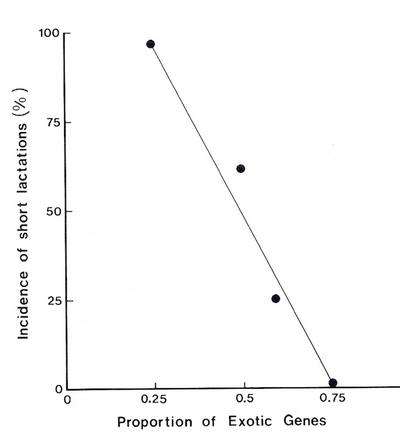 |
|
Figure 2.1 Effect of genotype (degree of crossing with Holstein and Brown Swiss bulls on Zebu cows) on the incidence of short lactation (<100 days). The cows were milked by machine without calf stimulation (Source: Alvarez et al. 1980). |
In traditional livestock systems most breeds are multipurpose, giving rise to a variety of outputs including draught power, milk, meat, wool and hides, in addition to providing a source of capital to be drawn on as required, especially following crop failure. The manure from animals, particularly from large ruminants, serves as fuel which can be either used in the home or sold or bartered, and can also be used as fertilizer.
It is therefore necessary to reassess the ``industrialised country" concept of livestock production as being made up of separate and highly specialised systems, identified by the nature of the end product, for instance: milk production, beef production, wool production etc.
In Third World countries, it will be argued, livestock must be a component of a much broader strategy which places equal, if not more, emphasis on sociological, ecological and political issues instead of being confined to parameters relating only to biological and economic efficiency.
In Asia and large areas of Latin America and Africa, a major role of cattle and buffaloes is to provide draught power. In terms of resource use there is no competition for food with humans or monogastric animals, since the basis of the diet of draught animals is crop residues---mainly straw from rice and wheat. This basic feed resource is often supplemented with small amounts of forage from communal grazing areas or from cuttings from road sides, which are carried to the animals.
There is a great need to rationalise the role of animal traction in developing countries. The draught animal has received little attention from researchers, and it is only recently that serious attempts have been made to define the relationships between work and nutrition.
The high biological efficiency of livestock systems involving draught animals has not been adequately recognised. Many livestock scientists also seem to have ignored the fact that low-protein fibrous feeds (crop residues) that are inadequate for growth and milk production of ruminants in specialised production systems support a large and increasing ruminant population in Asia (Jackson 1981).
If the response to supplements obtained with growing, milking and fattening animals on straw-based diets (see Chapter 8) could be reproduced with productive cows that also work, this would lend itself to the gradual replacement of work oxen by work cows. This requires that the interaction between supplementation and work is synergistic in increasing feed intake and the efficiency of utilisation of absorbed nutrients.
The nutrition of draught animals requires urgent research for the following reasons:
The high cost of machinery, spare parts and fossil fuel is favouring animal traction over mechanisation in many countries
In Bangladesh decreased farm size is forcing farmers to use cows for work (Dolberg 1982). This is because the use of productive cows for draught reduces the pressure on available feed resources. Not having to feed specialised draught animals makes available more feed for the remaining livestock which have multipurpose roles
Work may be a means of increasing the efficiency of utilisation of fibrous crop residues. Feed intake is increased by work, and the expenditure of energy improves the residual balance of nutrients, narrowing the energy/protein ratio in nutrients available for tissue synthesis and milk production. There is also the effect of the increased feed intake per se favouring the balance of nutrients (Chapter 4).
The low nutrient demand of pregnancy suggests that pregnant cows could be used for work at least during the first 6 months. This hypothesis is supported by the work of Lindsay et al. (1982), who reported increased cow liveweights at calving and heavier calf birth weights when pregnant beef cows on dry tropical grass hay were given supplementary feed during the last 60 days of gestation (Table 9.9). These data indicate that there should be no problems in combining work with reproduction, provided that the principles of supplementation are applied.
The use of lactating cows should also facilitate draught animal research since milk yield is easily measured and should be sensitive to the effects of both work and supplementation.
There are strong reasons for believing that the most economic way of meeting the increasing demand for milk and meat in developing countries is through improvement of existing livestock production systems based on multipurpose animals, rather than through development of specialised milk and meat production. It is understood that, in such multipurpose systems, the milk is partitioned between the calf and family consumption and/or sale; and that the calf consumes its share of the milk through some system of restricted suckling.
The bases for this argument are:
The relative consumption patterns of meat and milk in non-vegetarian communities
The competition of intensive milk production (more than 2000 litres/animal) for food suitable for humans and more efficient monogastric animals
The preference for high-fat milk, particularly in the Indian subcontinent (milk fat levels are higher in the milk of buffaloes and crossbred cows than in that of specialised dairy breeds)
The increasing role of draught animals and the requirement that the cattle herd should provide draught power for food crop production
High levels of milk production (eg. from specialised dairy breeds) are impossible in the humid tropics because the animals cannot get rid of the heat produced by the digestion and metabolism of the large amounts of feed required for high levels of production
In most countries, there is a need for flexibility in production because of lack of necessary infrastructure (eg. transport, processing and marketing facilities).
The relative meat/milk consumption patterns in a number of countries are shown in Table 2.1. The ratio for consumption of milk relative to beef appears to be fairly constant, at about 4 litres of milk for every kilogram of carcass meat, and seems to be independent of expendable income. This demand ratio has not been taken into account by livestock planners whose recommendations have invariably been to establish separate and independent milk and beef production systems.
|
Table 2.1: The demand ratio for milk and beef. This is reasonably uniform in three countries in different continents, despite considerable differences in purchasing power (ie. developed versus developing countries). |
|||
|
|
USA |
Colombia |
Pakistan |
|
Milk consumed (kg/person/yr) |
250 |
70 |
54 |
|
Beef consumed |
|
|
|
|
(kg/person/yr) |
53 |
]8 |
14 |
|
Milk/beef demand ratio |
3.9 |
3.7 |
4.7 |
|
Source: FAO (]980). |
|
|
|
The disadvantage of such strategies is that a specialised milking herd produces between 10 and 25 litres of milk/kg of meat (assuming that an intensively fed dairy cow produces 2000 to 6000 litres of milk annually and that the beef from her offspring and from the cow when slaughtered represents 250kg per year). Thus production is markedly imbalanced relative to the consumption pattern of 4 litres of milk/kg of meat noted above. If the male calves are slaughtered at birth (a common practice in highly specialised dairy enterprises in developing countries) the production ratio of milk to meat widens to 50:1. To satisfy a consumption ratio in the range of 3 to 5 litres of milk per kg of meat will require 4 or 5 beef cows to balance the milk and meat outputs from one high-yielding dairy cow. The net result of specialisation is a decline in numbers of dairy cows relative to beef cows in national herds.
Specialised dairy cows are biologically highly efficient. In contrast, specialised beef cows are inefficient, especially when the feed available will support more productive systems. This is because their productivity is governed by their reproductive rate, which is always less than one offspring per year and considerably inferior to that of other meat-producing species such as pigs, poultry, sheep, goats and rabbits.
Highly specialised beef herds which produce only meat (and hides) have developed largely in countries where grazing land is readily available (eg. in parts of North and South America, Africa and Australasia).
In developing countries specialised beef herds are rare, other than on government stations and on large commercial ranches, usually belonging to institutions, private companies or absentee landlords. Cattle herds owned by pastoralists and farmers are often a source of draught animals, and almost invariably some milk is taken for human consumption. In pastoral societies, this milk makes a major contribution to the human diet.
The increasing pressure on land for crop production means that grazing areas will steadily diminish, as will the quality of the grazing, as the less-marginal land will be cropped first. Sheep and goats may be the preferred species in future livestock developments because of their higher reproductive rate and multipurpose traits of meat, milk, wool and hair production. Growing of plants and trees which produce fuel as well as feed is another alternative that is becoming of increasing importance.
A major advantage of a multipurpose system is that milk taken by suckling is the ideal bypass supplement to complement feed resources (eg. crop residues) which otherwise give rise to ``imbalanced" nutrients. Thus the basal feed resource is used more efficiently. Better protein/energy nutrition in early life ensures a higher mature bodyweight, which could be important when animals are raised for draught purposes.
The indigenous cattle in most tropical countries have low genetic potential for milk and meat production and although such cattle are usually well integrated with the available feed resources, some genetic improvement will usually be necessary if improved feeding (eg. by supplementation) is to be fully exploited.
Creating new dual-purpose milk/beef breeds by selection within the indigenous population takes too long, and importing exotic breeds is undesirable in most cases. A better solution is to improve local animals by crossing with dual-purpose breeds (especially Friesian and Simmental) which have large bodies and therefore may produce better draught cows. The progeny of such crosses have excellent dual-purpose characteristics. Cows yield up to 1500 to 2000 litres of milk per lactation, which can be supported on locally available feeds. Their meat production potential is comparable to that of specialised beef breeds.
Herds of unselected crossbred cattle with more than 50% Bos indicus genes always contain some cows that are reluctant to ``let down" their milk without prior stimulation from, or in the absence of, their calves. This has led scientists to stress the advantages of developing breeds that have from 50 to 70% of their genes from European dairy breeds, since this appears to be the minimum level of exotic blood necessary to ensure adequate milk let-down without stimulation from the calf (see Figure 2.1).
 |
|
Figure 2.1 Effect of genotype (degree of crossing with Holstein and Brown Swiss bulls on Zebu cows) on the incidence of short lactation (<100 days). The cows were milked by machine without calf stimulation (Source: Alvarez et al. 1980). |
Inducing milk let-down without the calf is only a problem where high labour costs require that cows are milked by machine in a system that gives a high milk output per worker (eg. milking sheds incorporating herring-bone and rotary designs). Such management systems are inappropriate in most situations in developing countries, where the herd size is between 1 and 5 animals, family labour is readily available and the use of machinery is thus an unnecessary expense.
The major advantage of combining milking with restricted suckling is that there are biological advantages for both the cow and the calf (Table 2.2). There are also pronounced economic advantages from integrating calf rearing into the milk production system (ie. by restricted suckling), instead of raising them on cow's milk given from a bucket, as is apparent from the data presented in Table 2.3. Restricted suckling is discussed in further detail in Chapter 11.
|
Table 2.2: Advantages to cow and calf of restricted suckling. |
|
|
|
|
|
|
Table 2.3: Economic analysis of the effects of substituting artificial rearing with restricted suckling as the system of raising calves on the "Lucerna" farm in the Cauca Valley, Colombia. 200 cows were milked twice daily. Before restricted suckling was introduced, calves were given 400kg whole milk by bucket, which is the typical calf rearing system used on specialised dairy farms in Colombia. When the calves were suckled they were also fed a small amount of concentrate. |
||
|
Effect of incorporating restricted suckling into management |
Quantitative change (kg/month) |
Effect on cash flow (US$/year) |
|
Increased milk yields |
6500 |
15650 |
|
Improved calf growth |
20 |
2509 |
|
Decreased incidence of mastitis and need for antibiotics |
|
320 |
|
Extra concentrate for calves |
1068 |
-2669 |
|
Increased cash flow |
|
15760 |
|
Source: Preston 1987 |
||
Nutritional and environmental factors are important constraints to ruminant productivity in the tropics. Nutrition, disease and parasites limit the expression of genetic potential, especially in imported pure-bred animals. When environmental stress is high native breeds may outperform exotic breeds, which only demonstrate their superior genetic potential when environmental conditions are favourable (Table 2.4). An important feature of the results was that each breed in turn outperformed the others depending on the severity of the imposed stresses.
|
Table 2.4: Post weaning live weight gains of three cattle breeds at three different levels of stress. |
|||
|
|
Live weight change, kg/d |
||
|
Stress level |
Brahman (B) |
BxHS |
Hereford
x |
|
Low |
0.75 |
0.81 |
0.84 |
|
Medium |
0.29 |
0.37 |
0.27 |
|
High |
0.25 |
0.21 |
0.11 |
|
Source: Frisch and Vercoe 1979 |
|||
These genotype-environment interactions have major influences on the productivity of livestock in the tropics and must be taken into account when production systems are being planned.
An interaction between nutrition and genotype is illustrated by the data in Table 2.5. When a nutrient was limiting in a diet (in this case, bypass protein), there was no advantage in using the genetically superior crossbreed as compared with the unimproved Zebu. However, the crossbreed performed as well as the Zebu on the deficient diet, and on the balanced diet (supplemented with fish meal) the crossbreed was much more productive than the Zebu.
|
Table 2.5: Performance of commercial Zebu cattle and their crosses with Brown Swiss on molasses-based diets supplemented with poultry litter or fish meal. The potential of the "improved" crossbreed was only realised when the nutrient balance was improved by feeding a bypass protein (fish meal). |
||||
|
|
Poultry litter |
Fish meal |
||
|
|
BS Xsses |
Zebu |
BS Xsses |
Zebu |
|
Live weight gain, g/d |
600 |
550 |
950 |
700 |
|
Feed conversion, kg DM /kg gain |
10.2 |
9.6 |
73 |
8.2 |
| Source: Preston et al 1970 | ||||
The growth rate of crossbred cattle is rarely less than that of native breeds, but major problems can occur with milk production. The data in Table 2.6 indicate that when the fermentable energy density in the diet is low and nutrients arising from fermentative digestion are imbalanced (eg. on a diet of untreated rice straw) the crossbreed can be a ``high risk" animal because it continues to produce a high milk yield by milking ``off its back". Thus, the higher milk yield of the crossbreed is at the expense of body tissues. It appears that the crossbreed's propensity to produce milk is too highly developed in relation to its capacity to maintain body reserves. However, when the digestibility of the straw was increased by ammoniation (urea-ensiled) the crossbreed was more productive than the unimproved Zebu, and gave both higher milk production and faster accumulation of body reserves.
|
Table 2.6: Performance of lactating crossbred (X-bred) and unimproved local cattle in Bangladesh given basal diets of untreated (straw) or ammoniated (urea ensiled) rice straw (NH3-straw). Additional supplements were Napier grass (O.4kg/d DM/d) , rice bran (O.45kg DM/d) and oilseed cake (O.2 kg/litre of milk) plus minerals |
||||
|
|
Straw |
NH3-straw |
||
|
|
Local |
Xbred |
Local |
Xbred |
|
Milk yield (kg/d) |
0.4 |
1.5 |
2.0 |
2.5 |
|
LWt change (g/d) |
-80 |
-210 |
50 |
180 |
|
Source: Khan and Davis 1981 |
||||
The above example is an extreme case, in that the nutritional value of unimproved rice straw is very low. For more moderate degrees of stress, the crossbred milking cow is usually to be preferred, as shown by the results from a crossbreeding experiment in Brazil (Figure 2.2). Genotypes ranging from Holstein through to Zebu with all intermediate crosses were evaluated on commercial farms with different levels of management. On the ``poor" farms, the F1 (Holstein x Zebu) was superior to either parent, while on the ``good" farms, its performance was better than Zebu but still comparable to pure Holstein.
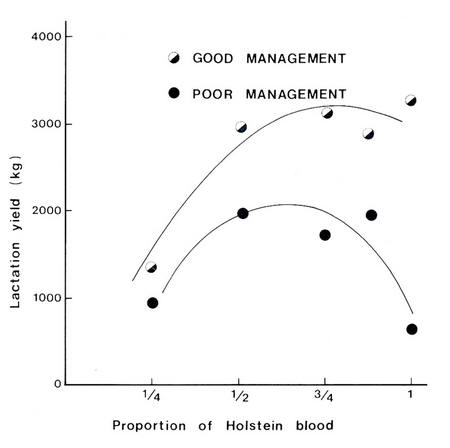 |
| Figure 2.2 Performance of Holstein: Zebu crosses in commercial farms grouped according to level of management (Brazil) (Source: Magdalena F, personal communication. |
These data highlight the importance of management strategies and appropriate genotypes (ie. dual purpose) which permit the buildup of body reserves in late lactation and pregnancy that can be mobilised to provide a balance of nutrients for efficient milk production in the subsequent lactation (see Chapter 4).
On diets based on crop residues and sugar-rich byproducts the consequences of the wrong strategy (ie. using animals that partition too much dietary energy to milk production at the expense of body reserves) are:
A rapid fall in milk yield early in lactation
A further decrease in body condition leading to
reduced conception rate
shortened productive life
increased susceptibility to disease/parasitism.
In ruminants, a large amount of heat is produced by fermentative digestion and by metabolism, especially on diets high in fibre. The amount of heat produced is proportional to the amount of feed eaten, which is twice as much for a cow giving 18 litres milk daily as for one giving 5 litres. In cool environments this can be an advantage in that it permits highly productive cows to live comfortably without extra feed at temperatures below freezing.
As air temperature approaches body temperature, it becomes increasingly difficult for the animal to lose the heat that it produces. When its normal body control mechanisms are inadequate, the animal reduces its feed intake but continues to produce milk by drawing on its body reserves.
In some situations, the environment can be modified by sprinkling the cows with water and by using shades to keep the cows cool. This works in dry climates, and in the tropics at elevations of 500 to 1000 m where night temperatures often fall to 20°C or less. But in the humid tropics, where night temperatures are often still above 30°C, it is physiologically impossible for ruminants to lose the heat produced by the digestion and metabolism of the quantity of feed necessary to support high milk yield.
Therefore, on purely physiological grounds, there is no place in the humid tropics for the high-yielding dairy cow. The economic advantage of lower yields derives from the fact that most of the nutrients needed can be supplied from the available feed resources, such as native pastures and crop residues.
In the light of the above it is easy to understand why there are misconceptions about the need for heat tolerance in cattle in the tropics, particularly for milk production. The first limiting factor is usually feed supply. It is rarely economic, and then only by some form of subsidy, to provide the high- energy/high-protein feeds needed to sustain high levels of milk production. The cost of modifying the animal (selection for heat tolerance) or the environment is therefore rarely justified, as this is secondary to the nutritional constraint.
Most developing countries cannot afford the cost of overcoming both the nutritional and the environmental constraints associated with high levels of milk production. The amount of feed available, even when balanced for nutrients, supports only moderate levels of production. Under these conditions heat tolerance is much less important.
In almost all production systems in developing countries animals are either herded (when grazing) and held overnight in yards or houses, or intensively supervised as in the tethered husbandry systems. Under these conditions, ectoparasites are often controlled by hand picking. Furthermore as grazing systems give way to settled agriculture, there are fewer ecological niches for particular disease vectors (eg. tsetse fly) and this lowers the disease challenge.
Endoparasites are always a major problem, particularly for the young animal. Older animals are, however, resistant to most endoparasites with the exception of liver flukes.
Breeding strategies must take account of these factors. They must be flexible and should always be pursued against a background knowledge of the modifying effects of the environment.
Several attempts have been made to develop new breeds of cattle for tropical conditions. Many of these have been beef breeds intended for extensive grazing situations and large ranches, and thus have little relevance to small farms where draught power and milk production are the most desirable traits.
The thesis put forward in this chapter questions the development of specialised breeds for the tropics. While the biological advantages of breeding for heat tolerance and tick resistance are undeniable, the cost-benefits and the time needed for such programmes may be questionable. There is almost no justification for the emphasis placed on milk let-down without the calf.
The integration of livestock with crop production is a means of establishing sustainable farming systems that aim to optimise resource use (Chapter 1). The realisation of such aims will maximise the degree of self reliance of the systems, since a variety of products will be obtained with minimum inputs to maintain soil fertility. The varied activities on the integrated farm create employment opportunities for all members of the extended family.
Mechanised cropping systems tend to be high cost since they use a lot of fossil-fuel-derived inputs. In developing countries the relative unavailability to small farmers of fossil fuels (because of cost) has encouraged greater self reliance on home-grown draught power, fuel and food. This is best accomplished by integrating crop and animal production and by recycling wastes (to minimise the need for outside inputs and to reduce pollution) (Figure 2.3). Progress is being made in Asia (see for instance Edwards et al. 1983) where large and small ruminants and pigs are integrated with the production of ducks and fish on the recycled waste. The subject, although of great importance, is beyond the scope of this book. Components within these strategies are, however, discussed in subsequent chapters.
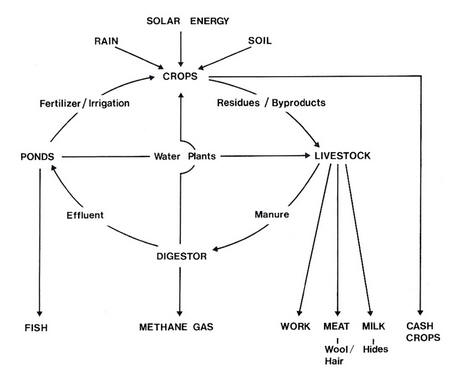 |
| Figure 2.3 Flow diagram for integrated farming systems. |
A large part of this book is concerned with making more efficient use of native pastures, crop residues and fibrous agro-industrial byproducts by ruminants. However, these feeds do not contain the balance of nutrients needed to support both efficient rumen fermentation and high animal productivity.
The supplements needed to balance these feed resources for ruminants are largely high in protein and arise from a variety of sources. Oilseed cakes and byproducts of animal processing are the first choices in situations where these are available and under-utilised. The amounts available are, however, limited and often the argument for exporting them to earn foreign exchange is difficult to counter. There are therefore many advantages from growing protein supplements on the farm.
A legume plays two roles in a crop rotation: it fixes N which can be used by a subsequent crop and provides a fodder supplement that supplies fermentable N, other nutrients for the rumen microbes, readily fermentable cellulose and bypass protein. Legume crops should be assessed in terms of their ability to provide these factors. In addition the possible presence of phenolic compounds and other chemicals that may affect the availability of these nutrients should be investigated. It is logical to use legumes as a supplement (ie. they should be fed as a small proportion of the diet, see Chapter 7).
Tree crops are highly appropriate for the tropics. They capture a large amount of solar energy and, in high and low rainfall areas, they produce sustainable yields of biomass. They reduce erosion, improve soil structure and fertility and plants with shallow roots can be grown under the trees.
In marginal areas where dry seasons are prolonged, the deep roots of the trees allow greater exploitation of water and mineral reserves in the soil profile. Some trees also provide green biomass of high digestibility and high protein content at a time when feed reserves are scarce and mostly low in N.
Many of the fodder trees are leguminous and therefore have the added attribute of fixing atmospheric N. They are also a timber cash crop, a fuel bank and provide shade.
The classical use of tree crops has been to provide export commodities (eg. palm oil, coconut oil, cocoa and rubber). Animals have had a low priority in these systems and rarely even graze under the trees. Where animals do graze under the trees, it is usually as a minimum-input system with no attempt at pasture improvement or to increase the efficiency of its utilisation.
Animal productivity could be increased by establishing legumes under the trees, which would benefit both trees and livestock. The legumes grown would be ideal supplements in livestock systems based on crop residues.
New uses for tree crops are as sources of fuel, timber and feed. Their use as fuel and timber is outside the scope of this book. Their advantages as sources of forage are the high protein content and high digestibility of the leaves, which do not decrease as the tree matures. The specific role of forage trees is as a supplement to crop residues and they should not be considered as forming the basis of the diet (see Chapter 8).
Intensive livestock units in the industrialised world have been planned and sited according to the primary objectives of maximising animal productivity and minimising operational costs.
This has led to the use of feed resources with high energy density and with a high protein content. These feeds are generally compounded with modern equipment that facilitates mechanised feeding. The heavy investment in machinery has led to the establishment of large units with high animal densities. Waste disposal in these large enterprises has become a major problem. The issue is not only the cost of disposing of the waste materials, but the pollution caused by the animal density exceeding the available land area for disposal. Accumulation of wastes, the cost of their disposal and pollution of the environment are serious consequences of the intensification of livestock enterprises.
In contrast to the situation in industrialised countries, the wastes from crop and livestock production in the developing countries are valuable sources of fuel and fertilizer, items that are scarce and expensive. Fuel for cooking can be obtained conveniently from animal waste by anaerobic digestion to produce methane, since this proceeds efficiently when the proportion of solids in the substrate is between 5 and 10%, which is close to that of excreta of cattle and pigs. Recycling excreta through biodigestors to produce methane avoids the loss of nitrogen and other plant nutrients which occurs when dried dung is burned for cooking. The effluent from the digestor is a valuable fertilizer because it contains most of the plant nutrients present in the original excreta.
The major constraint to widespread acceptance of biogas technology has been the high cost of the early digestors, which were built of concrete and steel. Simpler designs are now available which use plastic film (Botero and Preston 1987). These are easier to construct and install and are especially suitable for households that have only one or two animals. They are particularly appropriate in the many areas of the Third World where the provision of fuel for cooking is becoming increasingly expensive in terms of collection time and soil erosion.
 |
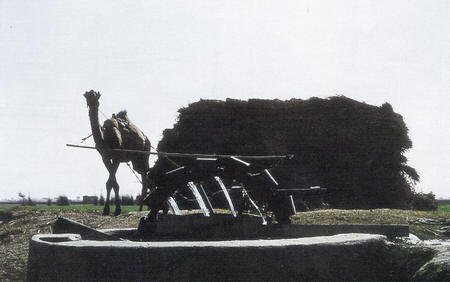 |
| Fuel is extremely scarce in some countries; in Ethiopia all forms of transport are used to collect fuel (wood) for household use (Lewis K) | Draught power in all forms is important in the
developing countries (Leng R A0 |
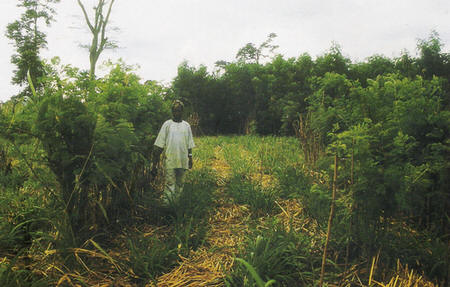 |
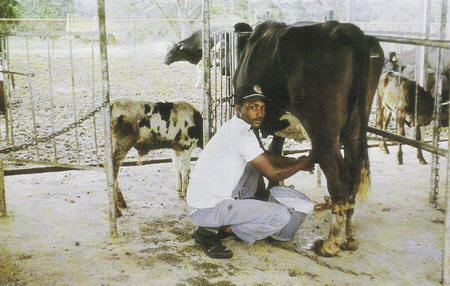 |
| Intercropping with forage trees to provide protein for goat production in Nigeria (van Houtert M) | Restricted suckling in milking herds in Dominican
Republic (Ffoulkes D) |